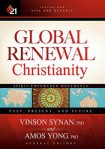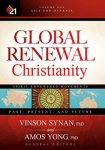Global Renewal Christianity is a four-volume series of books commissioned by Empowered21 and edited by Vinson Synan and Amos Yong. It consists mostly of papers presented at scholarly meetings convened by Empowered21 in Oxford, England (2012), Sydney, Australia (2013), Quito, Ecuador (2014), and Jerusalem, Israel (2015). The overarching purpose of those scholarly meetings, according to the Series Preface, was “to study the past, present, and future of the Empowered movements on every continent and from as many nations as possible” (xv). The final, edited version of the papers have been gathered into four volumes: Asia and Oceania (Volume 1), Latin America (Volume 2), Africa (Volume 3) and Europe and North America (Volume 4).
In the Introduction to Asia and Oceania, Amos Yong states the volume’s purpose: “to provide a reliable historical guide to Pentecostal and Charismatic Christianity for students and others seeking initial coordination to the various expressions and manifestations of the global phenomenon in the Asian and Oceanian context” (xxxix). Following the Introduction are twenty-one chapters divided into five parts: (1) South Asia, with chapters on India and Sri Lanka; (2) East Asia, with chapters on China, Taiwan, South Korea, and Japan; (3) Southeast Asia, with chapters on Vietnam, Thailand, Singapore and Malaysia, Indonesia, and the Philippines; (4) Oceania, with chapters on Australia and New Zealand; and (5) Roman Catholicism and Other Theological Themes.
Asia and Oceania contains many well-written, informative essays. Amos Yong’s Introduction, “The Many Tongues of Asian and Oceanian Pentecostalisms: An Introduction and Some Theological Prognostications” (xxv–xxxix) is a helpful overview of the irreducible diversity of “Asian and Oceanian Pentecostalisms,” considered under five headings: (1) ethnic and linguistic diversity, (2) cultural and religious plurality, (3) social and political variety, (4) economic-class disparities, and (5) ecclesial traditions and traditionings. This diversity makes it difficult to offer generalized statements about the movements the book explores, a difficulty manifested in the wide variety of terms Yong himself uses to describe the object of study: Pentecostalisms, Pentecostal, Charismatic, Pentecostal/Charismatic Christianity, etc. Writing about the Philippines, Giovanni Maltese and Sarah Essel note that Filipinos whom scholars would classify as “Pentecostal/Charismatic” reject both terms as self-descriptions (255–258), which only further complicates the issue of proper terminology. Regardless, the book evinces the settled scholarly conviction that despite their variety, these movements are species of a larger, Pentecostal—for lack of a better term—genus. This review will use Pentecostal as the catchall term, even as it acknowledges the descriptive limitations of doing so.
Most of the chapters in Asia and Oceania provide at least some historical background information regarding how Pentecostalism came to the country under examination. While the Azusa Street Revival and North American classical Pentecostal missions played a role in many cases, they did not play a role in all cases. In many other cases, indigenous or European revivals and missions agencies took the leading role. So, for example, Indian Christians were already manifesting “Pentecostal phenomenon” in the late nineteenth century, well before Azusa Street (2). The first Pentecostal missionaries to Thailand were Verner and Hanna Raassina of the Finnish Free Foreign Mission (198). And Azusa Street was “of minimal importance” in the initial development of Australian Pentecostalism (316).
It is common to hear classical Pentecostals in the United States point to the explosive growth of Pentecostalism worldwide as proof of classical Pentecostal doctrine and practice, but the chapters in this book render that simple judgment problematic. For one thing, Pentecostalism is now growing explosively everywhere. In Japan, for example, Christianity has a “long history,” but “its growth has been minimal,” despite the combined efforts of both Pentecostals and evangelical Christians. Moreover, Japanese converts have a “high defection rate,” with most converts leaving the faith “2.8 years after water baptism” (159). For another thing, as James Hosack and Alan R. Johnson point out in their chapter on Thailand, growth cannot be correlated directly with classical Pentecostal doctrine. “Contrary to Pentecostal rhetoric in the West, recent research shows that Pentecostal groups have not grown significantly faster than their non-Pentecostal counterparts. However, Charismatically inclined Christianity has produced the most robust growth” (196). This seems also to have been the case in Australia (301–305).
Moreover, the book’s chapters provide ample confirmation that Pentecostalism in Asia and Oceania suffer similar types of problems as North American and European Christianity. Division, for example, is a recurring theme in the book. This is most evident in the division between Trinitarian and Oneness Pentecostals, but it also pops up in the early conflicts between classical Pentecostals and the Charismatic Renewal Movement, especially the Catholic Charismatic Renewal Movement. And, of course, there are the continuing tensions about the Prosperity Gospel, megachurches, worship styles, and the like.
Additionally, there is the constant tension expressed in many essays between contextualization and syncretism. For example, Finny Philip’s essay, “Christological Nuances in Bhil Pentecostal Theology” (1–15) shows how the “Bhil tribal worldview” resonates with Pentecostal themes of Jesus as healer, exorcist, provider, protector, Savior, Lord, and Supreme God. However, this contextual advantage has an inherent danger if the tribal worldview becomes “a vehicle that traps people and communities if it is overemphasized theologically” (13). Similarly, Sang Yun Lee’s “The Kingdom of God in Korean Pentecostal Perspective” (143–157) examines how Korean Pentecostals began to refer to God as Joeushin Hananim (“Good God”) after the depredations of the Korean War as a way of capturing God’s holistic care for the human person, body and soul. “However,” he goes on, “Joeushin Hananim has to be understood differently from the shamanistic quest for material blessings” (156).
The gospel must be contextualized, but often, what indigenous Pentecostals take as “gospel” has been unduly shaped by missionary doctrines and practices. Thomson K. Mathew’s “Indian Pentecostalism in Kerala and the Diaspora” (41–63) identifies the wearing of “ornaments” as an issue in Keralite Pentecostalism. It is not entirely clear what “ornaments” are, but the practice seems to have stemmed from Brethren influence on Keralite Pentecostalism (61). Mathew writes: “The issue of ornaments remains a highly charged one in the Pentecostal churches in America and Canada. There have been church splits and leadership changes because of this issue” (53). Here, the issue seems to be a concept of holiness derived from North American missionaries that unnecessarily runs against the grain of an indigenous culture. Similarly, Ekaputra Tupamahu’s “American Missionaries and Pentecostal Theological Education” (233–254) argues that there is “a need for Indonesian Pentecostal scholarship to reflect on the history of the movement, react to the dominant American mentality, and rebuild a new narrative from their social location. The narrative Indonesian Pentecostalism has been largely dominated by the voices of missionaries” (emphasis added). What is needed is “an authentic indigenous form of Pentecostal spirituality” (254).
While the book is helpful in the several ways described above, it also has several notable flaws. The Series Preface notes the first and most glaring flaw of the series as a whole when it says, “in a good number of cases our first choices were not able to participate because of other commitments or circumstances” (xvi). This is a shocking admission to make to readers, who then wonder whether they are reading the best scholarship on a given country or region. Second, perhaps flowing from the first flaw, is the inconsistent quality of the chapters. Third, Asia and Oceania contains chapters on countries in South Asia, East Asia, Southeast Asia, and Oceania, but none on countries in West Asia, Central Asia, or North Asia. This means that Pentecostal and charismatic movements in the Islamic Middle East (i.e., West and Central Asia) receive no treatment in this volume or any other volume in the series. (Israel is bizarrely included in the volume, Europe and North America). Fourth, Asia and Oceania’s of China is thin, despite the fact that Chinese Pentecostals constitute the largest group of Pentecostals in Asia and Oceania. Similarly, the treatment of Oceania focuses solely on Australia (three chapters) and New Zealand (one chapter). While there is mention of the indigenous people in these chapters, the primary focus is on white colonists or, in one chapter, Chinese immigrants. These four flaws limit the value of Asia and Oceania as a whole, even though individual chapters within it can be excellent.
 Book Reviewed
Book Reviewed
Vinson Synan and Amos Yong, eds., Global Renewal Christianity: Spirit-Empowered Movements Past, Present, and Future, Volume 1, Asia and Oceania (Lake Mary, FL: Charisma House, 2016).
P.S. If you found this review helpful, please vote “Yes” on my Amazon.com review page.

